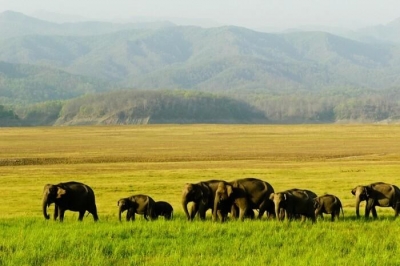For what Manas National Park is famous?

So far as natural habitats o, Manas is unusual - it is a wildlife sanctuary national park biosphere hotspot a UNESCO World Heritage Site, a Project Tiger and Project Elephant reserve. Located in Assam. Manas Wildlife Sanctuary is spread across 390 sq.km. The sanctuary is contiguous with the Royal Manas National Park of neighbouring country Bhutan. Located on Himalayan foothills, the sanctuary is fed both by monsoon rains and the Manas River it spans. The fertile Manas region is marked by riverine tracts rigged mountains, forested hills, tropical evergreen forests, mixed moist and dry deciduous forests and alluvial grasslands it nurtures about 60 mammal species over 40 reptile species and 500 species of birds. These include many globally threatened species too.
The danger tag
Pride of Assam, the Manas Wild Sanctuary became a UNESCO World Heritage site in 1985. But that joy was to be short lived in only seven years (1992), the sanctuary was places in the “danger” list by UNESCO due to several reasons budding poaching, general infrastructure degradation and the ethnic strife that dominated the region. And that tag was not easy to shake. It took several years of concerted effort from local activists and the government to in prove the conditions in the sanctuary Thong did take a while, the efforts eventually did pay off - in 2011, the region was struck off the danger let. Sadly a study in 2018 showed that Manas was one of the over 100 UNESCO World Heritage sites severely damaged by human activity The study also showed it had the most intense increase in human pressure.
Wildlife
Apart from the tiger and the Asian elephant the sanctuary hosts the greater one-horned rhino, swamp deer, pygmy hog, hispid hare, golden langur, clouded leopard, Assam roofed turtle, sloth bear and wild water buffalo. The bird species found here include pochards, francolins, nightjar, coucals, crakes, thickknees, plovers, jacanas, sandpipers, buttonquails, kites, buzzards, eagles, vultures, harriers, hornbills, woodpeckers, barbet, bee-eaters, kestrels, falconets, falcons, parakeets, pipits, buntings, tits, martins, starlings, garganey, mallards, common teals, little grebes, Bengal floricans and greater Adjutants. In addition Manas displays high plant diversity with at least 80 tree species 45 shrubs 35 under 170 herbs and 35 climbers. Among these, the many varieties of orchids ferns and grasses make for vital forage for the hooved mammals roaming the region
Threat
After poaching one of the main areas of concerns about the region has been invasive species. This is not an animal but two plant varieties from South America According to a 2019 study conducted by four researchers. the impact of the plant species Chromolaena odorata and Mikania micrantha - cannot be ignore The study says they are found in the Terai grasslands of the region and have been growing and expanding at an alarming rate over the years of these species continue to grow at the current rate the study said that over 15 of the total Manas area and 30 of the areca nuts are likely to come under the invasion This would mean significant reduction in the habitats of animals such as the Asiatic wild buffalo, one horned rhino, swamp deer and hog deer, and the eventual decline in their population.
Picture Credit : Google